Lessons from Crewing & Pacing an Iconic 100-Miler
Takeaways from my long weekend at the Western States Endurance Run
Welcome back, and welcome new subscribers. I hope you will subscribe if you haven’t already and share the link. Please consider upgrading your subscription to the supporter level to receive occasional bonus posts, an invitation to a monthly online chat, and most of all, deep gratitude for supporting my storytelling!
Before I share some stories and lessons from last weekend’s Western States Endurance Run, I need to tell you about something really important.
We have one week left—until July 5—to voice support for conserving public lands managed by the Bureau of Land Management (BLM). Last spring, the Biden administration proposed a rule that would elevate and enhance conservation of BLM lands. This article covers what’s at stake and what the proposed rule would do. To summarize:
“Intact BLM lands serve as vital habitat and migration corridors for wildlife; preserve cultural sites and a history stretching back millennia; offer outdoor recreation and related economic opportunities; and buffer the nation’s natural resources and communities against accelerating climate change. Yet with just 35 million acres of the 245 million acres managed explicitly for the conservation of their natural and cultural resources, and the vast majority available for leasing, drilling, and mining, BLM lands are also America’s most vulnerable public lands.”
For many years I’ve been a supporter of the Durango-based Conservation Lands Foundation, the only nonprofit dedicated to stewarding and growing the National Conservation Lands managed by the BLM. Please take a moment to click through to this link to urge the Bureau of Land Management to manage public lands to better protect and enhance wildlife, watersheds, cultural resources, and recreation.

The Western States weekend
I pulled an all-nighter Saturday, the kind that ultrarunners do to get through a 100-miler. I traveled to the Tahoe area last weekend to support a friend running the Western States Endurance Run, and even though I covered only 22 miles with him, I felt alternately exhausted and exhilarated from my role as a crew member and pacer. This newsletter is late today because I felt so tired and groggy—but happy—in the days following the event that I couldn’t focus on writing until today.
If you followed Western States at all last weekend, you know that 38-year-old champ Courtney Dauwalter made history by smashing the longstanding female course record by 78 minutes. She ran the 100 miles in 15 hours, 29 minutes, and sub-16 for women on this course previously was unfathomable. She finished 6th overall in a stout men’s field, and she made it look easy with her smile and smooth stride. (See iRunFar’s results article for details.)
I love Courtney—seriously, she’s a hero and big-time role model for me and countless others. The starting-line hug she gave me at 2021’s High Lonesome 100 carried me through that odyssey, along with a mantra “run like Courtney.” But I want to put her and other top finishers aside and tell you about some less exceptional runners and what we might learn from their experiences. I also would like to share some lessons re-learned from crewing and pacing.
(If you’re new to this newsletter and wondering what’s the big deal about Western States, read last week’s post for some context and history of the event. It holds a special place in my heart, and my sub-24-hour run there in 2016 counts as one of my proudest moments as a runner.)
A team effort
The lore of long-distance running paints a picture of an individual logging miles in quiet, sometimes lonely solitude, but the reality is that ultra-distance racing usually is a team effort imbued with camaraderie.
Crewing and/or pacing someone at an ultra is one of the best ways, along with volunteering at an aid station, to learn about the sport. It’s part apprenticeship, part paying your dues. It was my turn to help another runner as others have helped me.
Soon-Chul Choi, a friend I met in 2015 through a trail-running camp, asked me to pace and crew him, and I gladly said yes. He and his partner Naomi had paced and crewed for me in 2021’s Coldwater Rumble 100, and I had paced and crewed for Soon-Chul when he completed the Cocodona 250 that year. Naomi and a mutual friend, Jenny, and I formed Soon-Chul’s support crew. He had spent eight years trying to gain a spot in Western States, due to its long-odds lottery, so it’s an understatement to say this opportunity meant a great deal to him. We wanted to make damn sure he fulfilled his years-long goal.
After a white-knuckle travel day Thursday (Denver International Airport shut down for a few hours due to lightning and hail, which screwed up my two flights), I got into our group’s AirBnB after midnight but slept enough to thoroughly enjoy Friday, the day before the race, soaking up the scene at the ski resort Palisades Tahoe aka Olympic Valley (formerly Squaw Valley), where Western States starts. It felt like a reunion seeing old ultrarunning friends and legends in the sport.
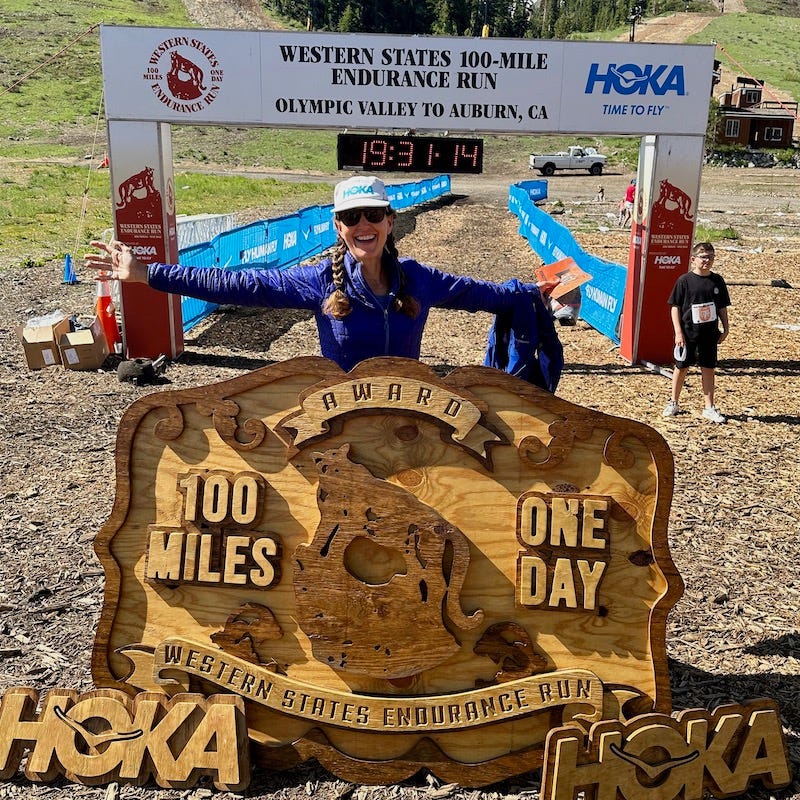
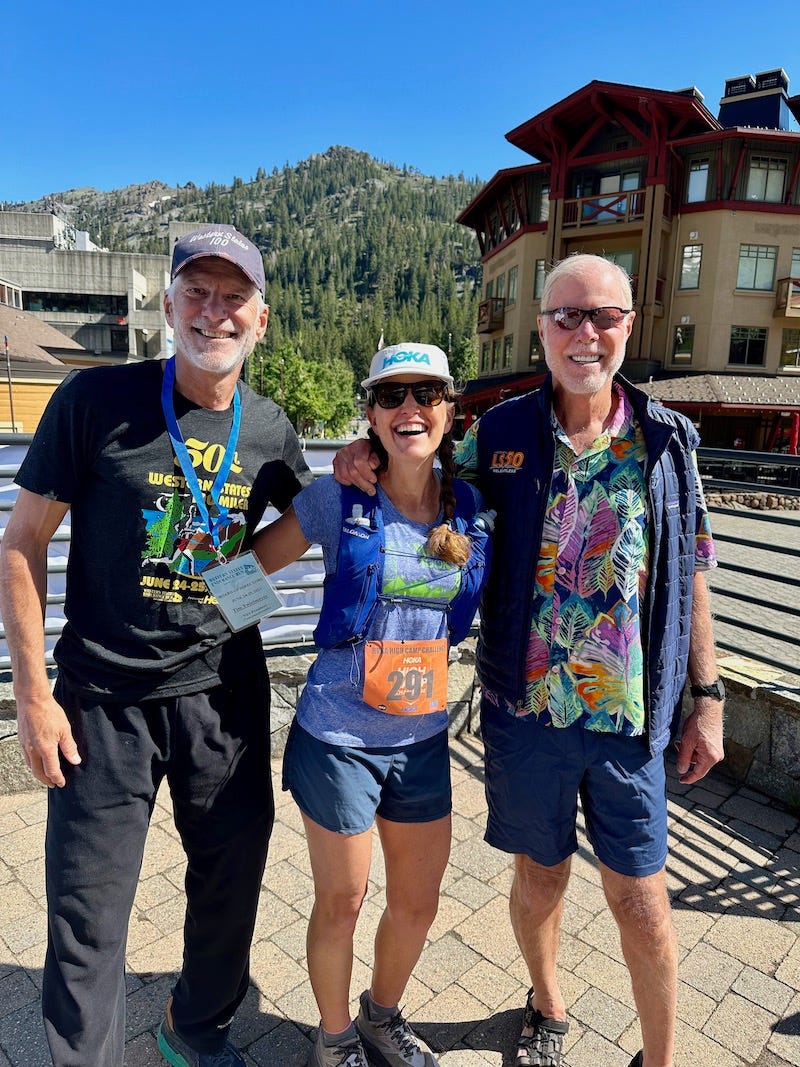
I jumped into a fun run Friday morning that followed the first three miles of the route, which climbs more than 2000 feet up a mountainside called the Escarpment, and shared the stretch with two former coaching clients and the incredible photographer Hilary Yang, with whom I bonded during our struggles at last summer’s High Lonesome 100 (check her Instagram for some of the best Western States shots!).
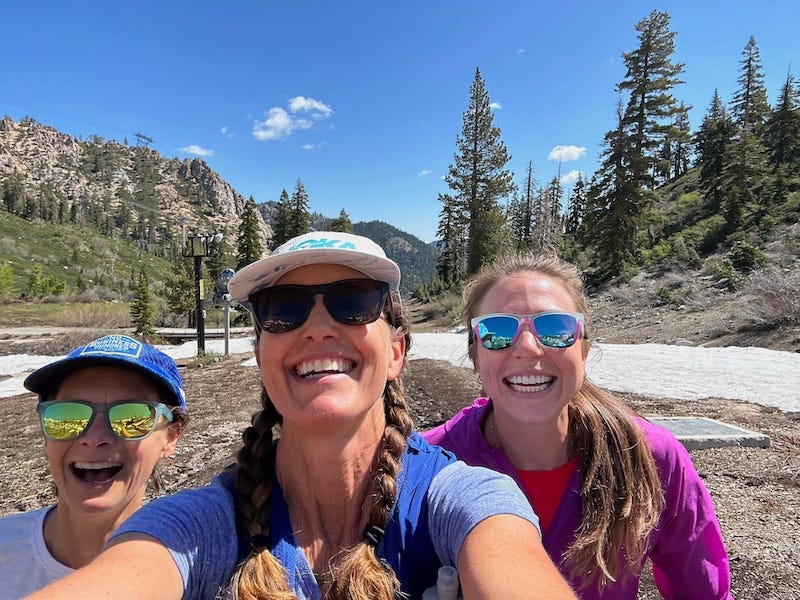
As much as I’m a Coloradan now, a big part of my heart remains in Northern California and the ultrarunning community there. NorCal looked its best last weekend, with the forests appearing healthier from the epic snowpack and the blue sky untarnished by wildfires. Best of all, we were treated to mild weather. Runners who had prepared for triple-digit heat in the canyons of the Western States Trail could enjoy blissful temps in the 70s.
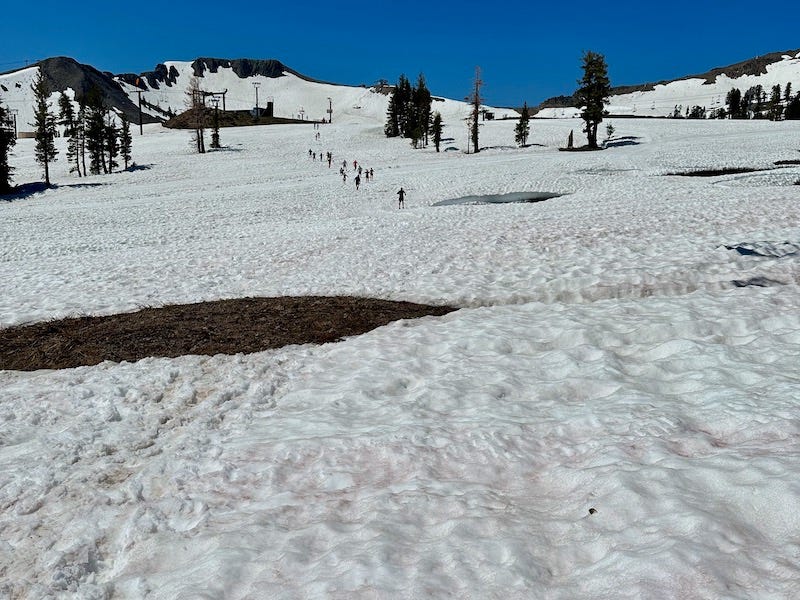
Not wanting to over-stress my knee, I took the tram instead of running back down and spent the ride talking to former Olympic marathoner and 2015 Western States champ Magdalena Boulet, who I used to hang out with in Oakland.
Magda personifies the humbling, democratizing aspect of ultrarunning. You can be a champ one year, and a regular volunteer or crew person the next. Elites mingle with midpackers. We all line up on the start line together. I can’t think of another sport like that.
Then, I shifted focus to Soon-Chul. Our group went over all the details for the following day—in particular, the plan to provide him what he needs at aid stations, and to share pacing duties during the second half of the race. Naomi, Jenny, and I sorted out the transportation and timing for getting to and from the meeting points without missing our runner. Getting to aid stations on time is one of the most challenging aspects of crewing, especially when the route involves long, windy backroads, parking challenges, and shuttle services to trailheads.
When we woke up around 3 a.m. to get ready for the 5 a.m. start on Saturday, we surprised Soon-Chul with team shirts. Key to successful crewing is making the runner feel special and the number-one priority!
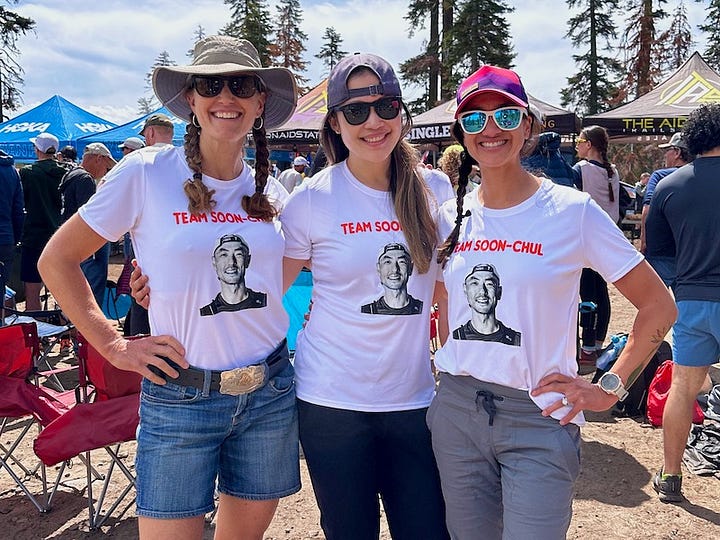
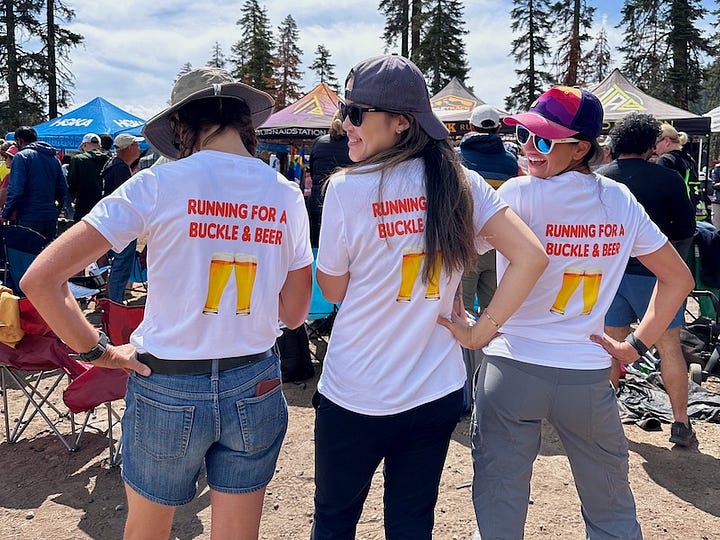
Hurry up and wait
The joke is that “crew” stands for Cranky Runner, Endless Waiting. We had to get to the first meeting point, at Robinson Flat (Mile 31), early to leave time for parking and shuttling. Plus, we didn’t know how early or late Soon-Chul might be, given the uncertainty of the high-country snowpack in the route’s first 30 miles.
We carried chairs, a cooler, and a gear bag to Robinson Flat and settled in for what would be about three hours. I welcomed the opportunity to observe how runners handled the aid station stop. Some top runners breezed through with smiles and hardly a pause, but others looked as grim and dejected as disaster victims.
Top competitor Nicole Bitter, for example, hobbled in with pain etched on her face, then laid on a massage table so physical therapist Joe Uhan could work on her. She reportedly fell in the snow, another runner accidentally slammed into her, and she wrecked her knee. Her race ended at Robinson Flat.
Then Coree Woltering came in farther back in the pack than expected, due to pain and the snow, and he burst into tears. All the pressure and disappointment poured out of him as he sat in a chair and cried with his face in his hands. I quietly watched and listened to coach Jason Koop sympathetically counsel him to accept and adapt to the circumstances and get back out there. He finished in 22:42, nearly three hours slower than his time in 2018, and he wrote on his Instagram: “At first I was pretty disappointed, but a finish is a finish. I wouldn’t have made it to the finish without a great crew.”
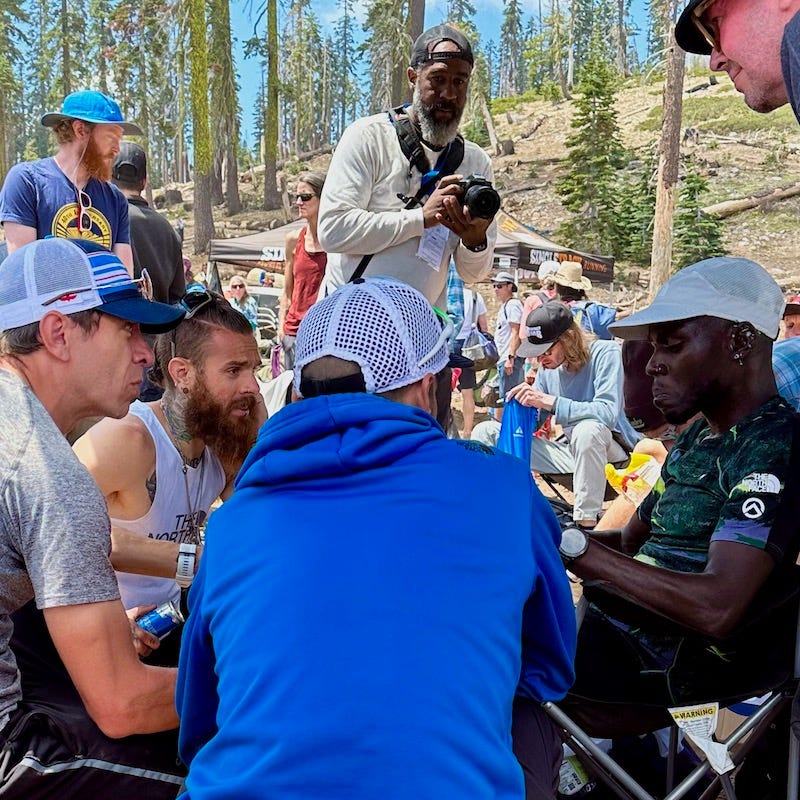
As the front-runners transitioned to mid-packers, I spent time talking to others who were there to crew, like Scotty Mills, a 20-time Western States and 10-time Hardrock finisher (see my profile of him, “Old School Hero,” here).
Observing runners giving their all, and talking with wise old-timers, imbued me with a sense of purpose and belonging along with motivation to train better and treat myself as a legit athlete rather than a casual has-been. In the back of my mind, I kept thinking, I’ve gotta up my training these next two months for Run Rabbit Run 100!
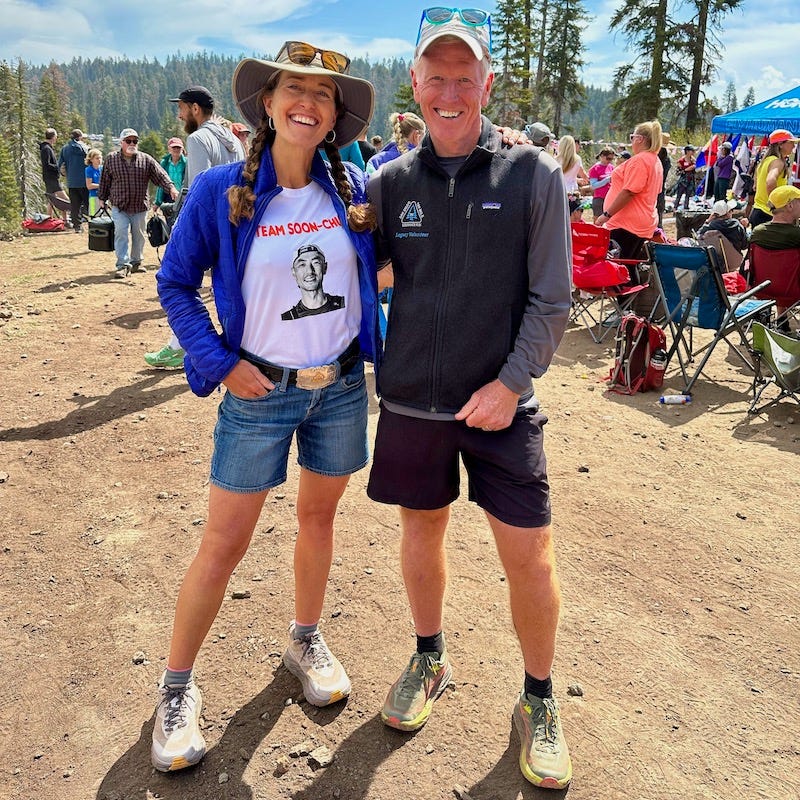
I hoped Soon-Chul would get there between noon and 1:00. To be on pace for a 24-hour finish would mean getting to Robinson Flat around 11:30 a.m. To be on pace for a 30-hour finish—the event’s cutoff time—means getting there around 1:10 p.m. The aid station cutoff was 2:10 p.m. That meant runners had to get through the aid station by 2:10—and, hopefully, make up time in the remaining miles—for a 30-hour finish.
Soon-Chul, age 45, wasn’t expecting a sub-24-hour finish this year, but he also wasn’t expecting to chase cutoffs. We anticipated that the slippery snow in the first 30 miles would slow him and others down significantly, but no one knew by how much. Additionally, he was coping with a painful muscle injury in his neck and upper back that clouded his performance. Our crew team knew we would need to boost his spirits and reassure him that he’d make up time in the miles to come.
1:10 passed. Finally, at 1:42, we saw him come up the hill toward the aid station, moving well enough but looking uncomfortable. He was all business—as ultrarunners should be when passing through aid stations—not complaining about the past difficult miles but rather focusing on what he needed for the miles ahead. Later, in the middle of the night when we were running together, he’d admit he thought about dropping out early because he felt so discouraged and in pain, but when we first saw him, he kept those thoughts to himself. He gulped down a recovery shake for a mix of carbs and protein, put a bandana filled with ice around his neck, and kept going.
Now our thoughts turned to meeting him at the next point, Michigan Bluff, at mile 55.7. We got in a slow-moving line for a shuttle back to the parking area and witnessed the heartbreak of worn-out runners arriving to the aid station at the cutoff time of 2:10 p.m., forcing them to drop out. Angie Woolman, the oldest female competitor at 69 and a friend who’s among this newsletter’s supporters, missed the cutoff by five minutes. I gave her a hug and felt so badly, because on any normal year with less snow, she would have made it. She was gracious and focused on the silver linings of being a part of the event.
In that shuttle line, I also chatted with Lucy Bartholomew, a top Australian runner I recognized partly because I’ve done her iFit videos. She finished 3rd at Western States in 2018 at only age 22, and she was there crewing for her dad, Ash, who was leapfrogging on the route with Soon-Chul. When I asked how crewing compared to racing the race, she said the crewing was harder because it took longer, and she worried about her dad. She and her siblings wore “Lucy’s Dad” shirts to support him.
We would see Lucy again at the Michigan Bluff aid station halfway, when her dad was ahead of Soon-Chul. But her dad’s back seized up and slowed him down. At 11:01 a.m. Sunday morning, in the most heartbreaking scene of the race, he entered the Placer High track in Auburn, where runners run three-fourths of a lap to the finish. His torso was fully bent over, at a right angle with his lower body, from pain and cramping. He still jogged forward and crossed the finish line with Lucy and other family members at his side, his family members crying yet cheering, two minutes too late to be listed as an official finisher and receive a buckle. Lucy’s Instagram post sums it up (click through to watch the video):
Night running and a rookie mistake
Adaptability is key to successfully crewing and pacing. Our original plan had me starting to run with Soon-Chul at Foresthill (Mile 62), but since he would arrive after 8 p.m. to Michigan Bluff (Mile 55.7), I could start pacing there. I welcomed these “bonus miles” as an opportunity to revisit a nice stretch of the Western States Trail, but I knew I had to get Soon-Chul to pick up his pace and build a time cushion for the 30-hour cutoff.
Finally, at dusk, we spotted Soon-Chul. He came into Michigan Bluff at 8:54 p.m., slightly behind the 30-hour pace of 8:50. I would run with him for 22 miles to the Rucky Chucky river crossing at Mile 78. The cutoff time there was 4:00 a.m., and I told Naomi and Jenny that my goal was to get him to the river by 3:30 a.m.
Heading out, I had flashbacks to when I ran this in 2016. But mostly I focused on Soon-Chul, who was wobbly and nauseous, his head and eyes cast down because lifting his head aggravated the pain in his neck and upper back. About a mile out of the aid station, he let loose the loudest dry-heaving I’ve ever heard, like a sick lion half-roaring, half-moaning, and I thought, Oh boy, this is going to be a long night…
But pacing means staying positive and acting like nothing is amiss. It’s also about telling the runner what they need to hear, even if it’s a white lie. So I told him he looked great, he was doing great, and he’d feel better soon. Rather than ask if he wanted to run instead of hike, I started slowly running and said, “C’mon,” knowing his pride would compel him to try to keep up with me. I gave us walking breaks on the uphills, then resumed running the flats and downhills. He put himself on autopilot behind me, copying my stride, and we started making better time and passing others.
I felt a thrill of running at night along this trail, my ears delighting in the sounds of crickets chirping and frogs croaking, which I don’t hear on the high-altitude mesa where I live. Soon-Chul started to feel better and to open up about the struggles of the early miles, and I said, “Let’s not dwell on that, let’s get to the river.” When we got to the Foresthill aid station at Mile 62, Naomi and Jenny took care of Soon-Chul while I had another mini reunion with old friends hanging out there, including Errol “The Rocket” Jones who crewed me back in 2016.
From there, Soon-Chul steadily improved, helped in part at aid stations by Mountain Dew and chicken broth with rice—two things he wasn’t planning on drinking or eating, but I persuaded him to ingest those calories with their mix of caffeine, sugar, starch, and salt.
That’s another strategy for pacing: act like a mom and tell your runner what he needs to eat and do because it’s good for him.
From about Mile 70 onward, we were running great and passing others until suddenly, with four miles to go until we met the crew, my Kogala light strip blacked out due to a dead battery pack. I had a backup headlamp, but its dying batteries had all the lumens of a firefly. I groaned with frustration at myself and my rookie mistake; I hadn’t packed more batteries because I didn’t think I’d share the trail with him for this long. I whipped out my iPhone and began running with it close to the ground, its flashlight beam barely adequate. I acted like it was no big deal, but inwardly I was freaking out that I might lose that light too. My night vision is awful. But I kept running, lifting my knees and feet extra high to prevent tripping on anything I couldn’t see.
Soon-Chul seemed pumped with motivation as we approached the river. We had built more than a half-hour cushion of time and arrived there at 3:22 a.m. Crowds of crew and volunteers took care of runners before they descended a rocky path, donned a life vest, and boarded a raft for the wide American River crossing. (In lower-flow years, runners enter the river and cross it holding a rope, but the river was raging this year.)
The only problem was, we couldn’t spot Jenny or Naomi. Soon-Chul made a snap decision: “I don’t want to lose momentum, I’m going!”
“Go, go, go, don’t wait! You’ll be fine,” I encouraged him, but I knew Jenny, who planned to start pacing him, would be upset at missing him, and Naomi was likely completely stressed out too. I waved goodbye as Soon-Chul boarded a raft, and then four minutes later, Jenny and Naomi arrived flustered and frustrated, having been delayed by an extra-slow shuttle.
The minute I saw Jenny, I yelled, “Get on the boat!” We wasted no time getting her down to the river, and less than 10 minutes later, fueled with adrenaline, she texted that she had caught up to Soon-Chul. Phew!
Around 4 a.m., Naomi and I got on a shuttle bus that bumped and swayed on the rocky backroad, and fatigue hit me like a truck as I nodded off with weird half-sleep dreams. Eventually, we made it back to our car and to a hotel room near the finish line, where I took a shower and fell asleep for about an hour. Then the alarm went off, and we had to hustle to meet Soon-Chul and Jenny at Pointed Rocks (Mile 94), where Naomi would start pacing him to the finish.
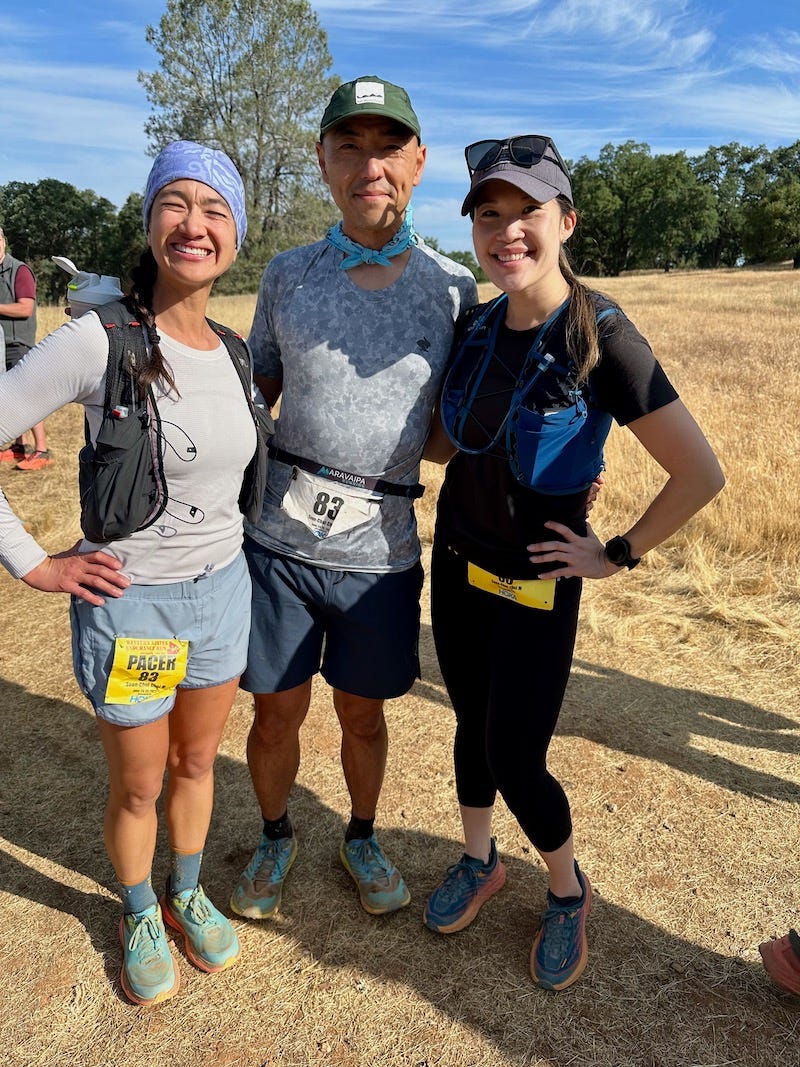
Going for the Golden Hour
The sunrise lifted everyone’s spirits. We all reconvened at Mile 94 at 8:30 a.m., Soon-Chul looking achy but determined. We knew at that point he’d make it within the “Golden Hour,” the final hour before the 30-hour cutoff, unless something went seriously wrong.
Jenny and I scrambled to drive to the finish area and park in time to accompany him and Naomi the final mile. I willed my sleepy body to run out to Robbie Point, Mile 98.9, where crews meet their runners to accompany them on the celebratory mile to the finish.
The energy along the neighborhood street in this mile feels electric. Rows of people sit on lawn chairs at the curb to cheer every runner, and the support grows for the back-of-the-pack participants because everyone appreciates that they’ve been out longer and have struggled more to make the cutoff times.
I screamed my head off for Soon-Chul and Naomi as they hiked up the steep hill to Robie Point, and then I joined them to fast hike and run a little. With about a half mile to go, Soon-Chul started running steadily and ran up a final hill in the neighborhood that I thought for sure he’d walk. Clearly, he was determined to empty his tank by giving his full effort.
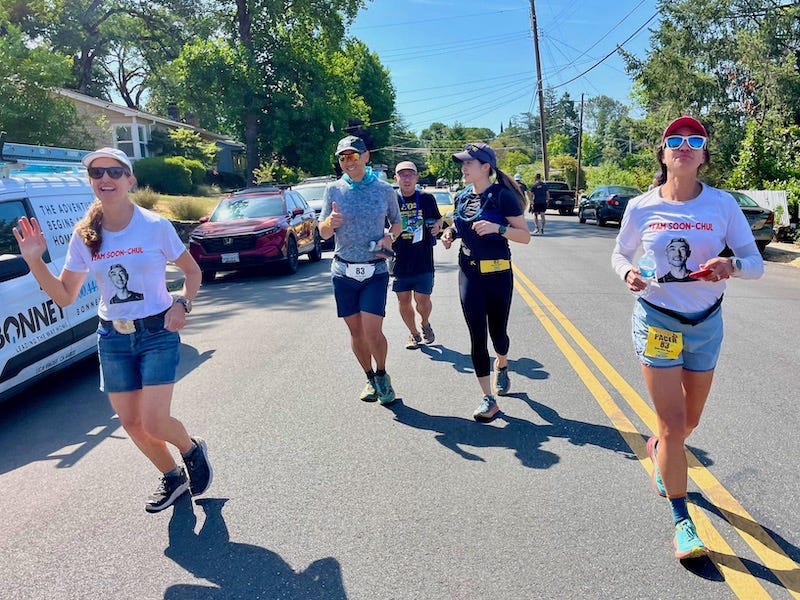
As the four of us approached the entrance to the high school track, where hundreds of spectators in the stands and on the field cheered finishers in the Golden Hour, I patted his back and said, “This is your Olympics, take it all in, you earned this!”
The three of us crew women followed Soon-Chul, who sprinted around the track as best he could. I felt elated and proud to be part of this team and to witness this moment. I always said the 100-mile Western States Endurance Run was a once-in-a-lifetime experience that lived up to the hype, so once was enough, but being on that track sparked a desire to qualify and get drawn to run it again.
Soon-Chul finished 43 minutes ahead of the cutoff, proud and relieved to finish strong and earn the buckle. He didn’t give up even though his mind had argued to quit to relieve the physical pain and emotional disappointment of being farther back in the field than he hoped to be. As is usually the case with ultra-long ultras, he bounced back from the low points and found a hidden reserve of energy and determination.
The Western States Endurance Run did what it has always done in its 50 years: revealed and displayed the human spirit in the extreme.
I’m so grateful to Soon-Chul Choi for this opportunity to share his run, and his story, and to be a part of the Western States Endurance Run again, and grateful to Naomi Lee and Jenny Perez Alvarez for being the best crew.

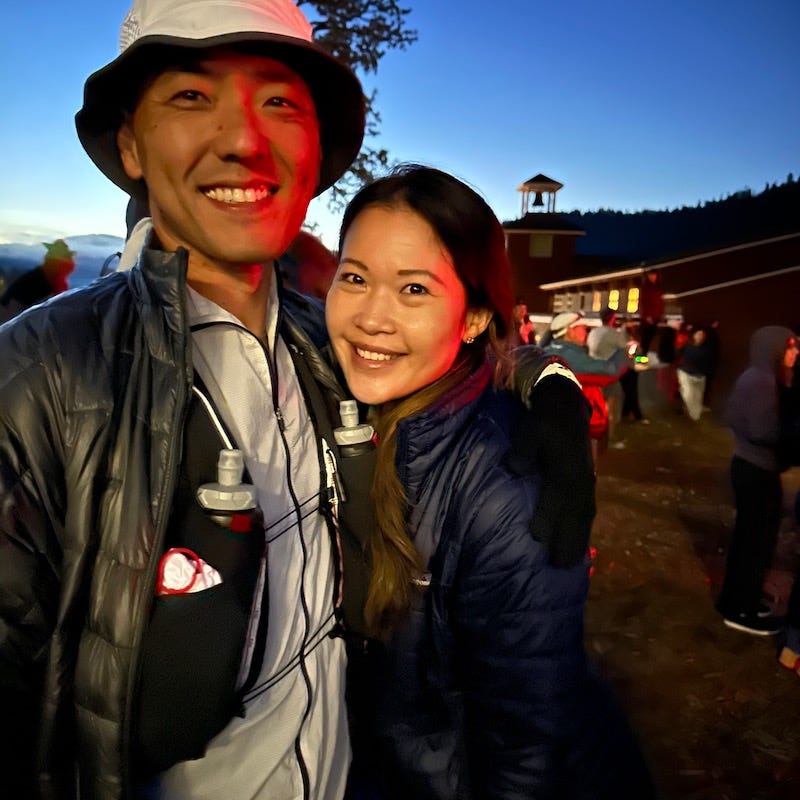

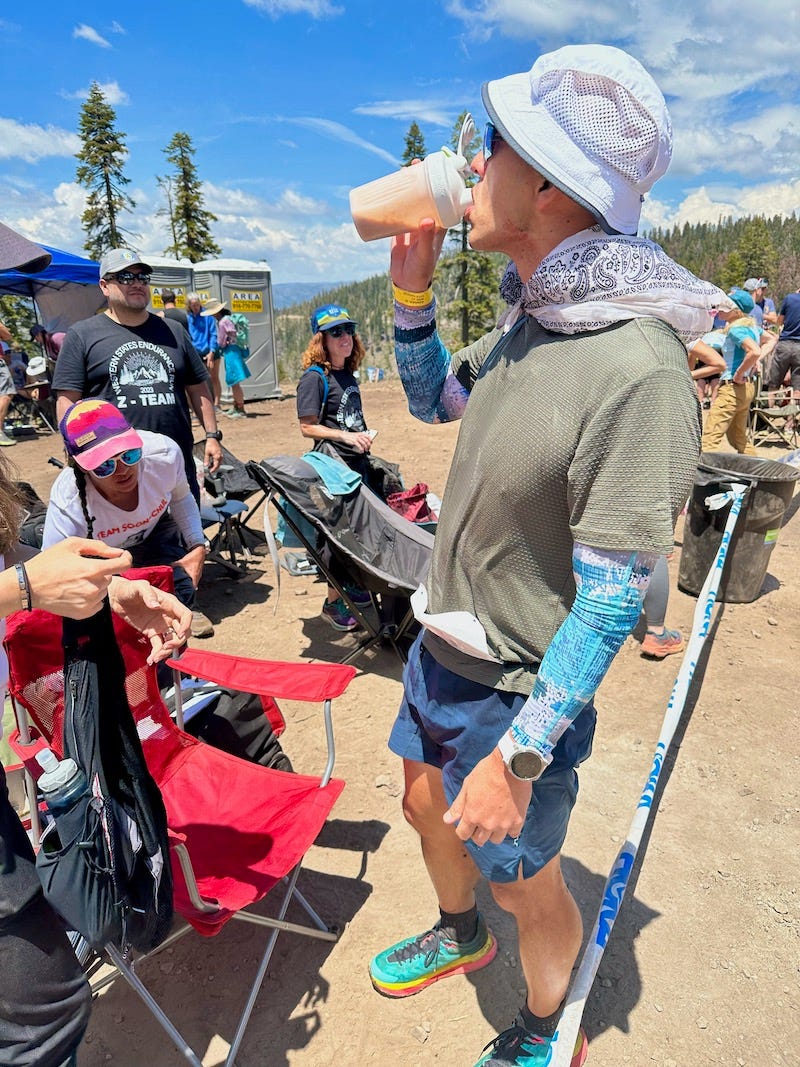

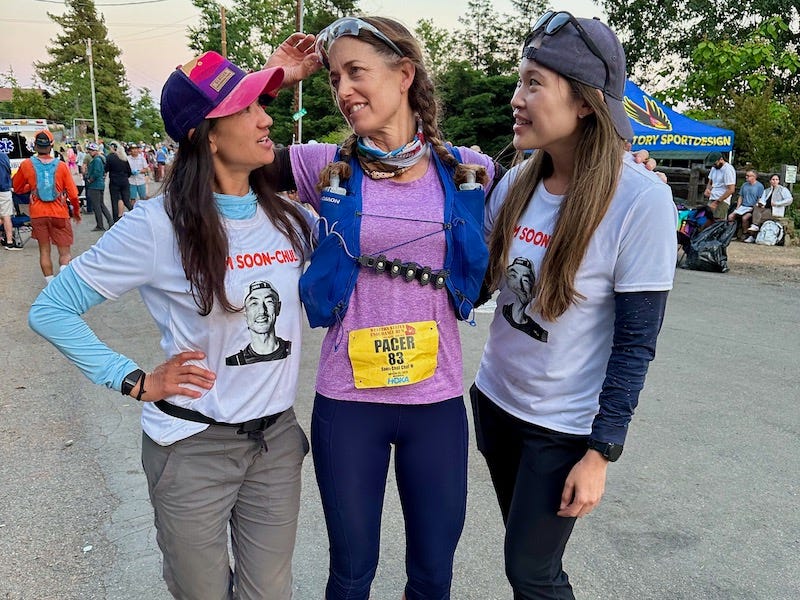
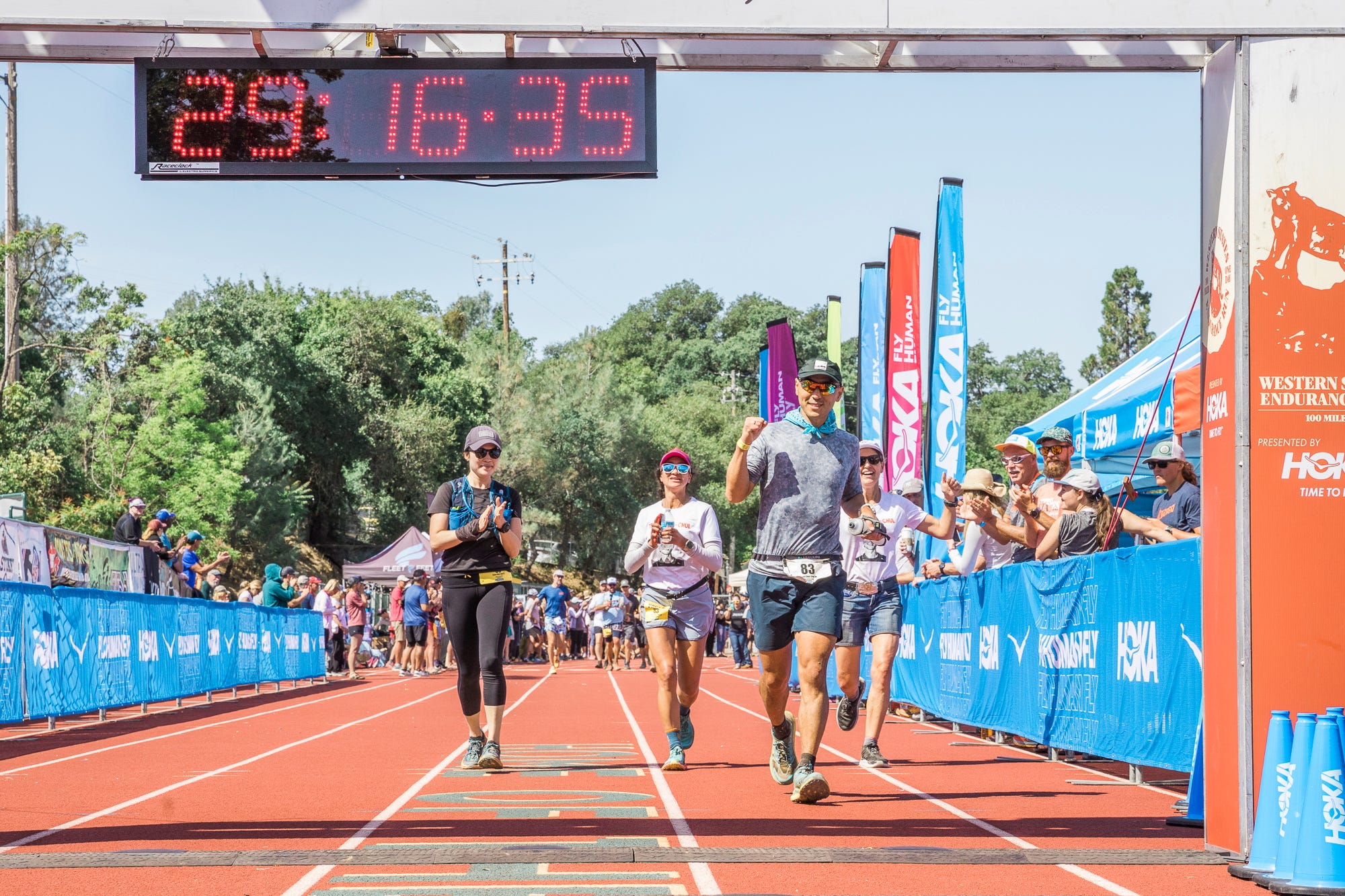
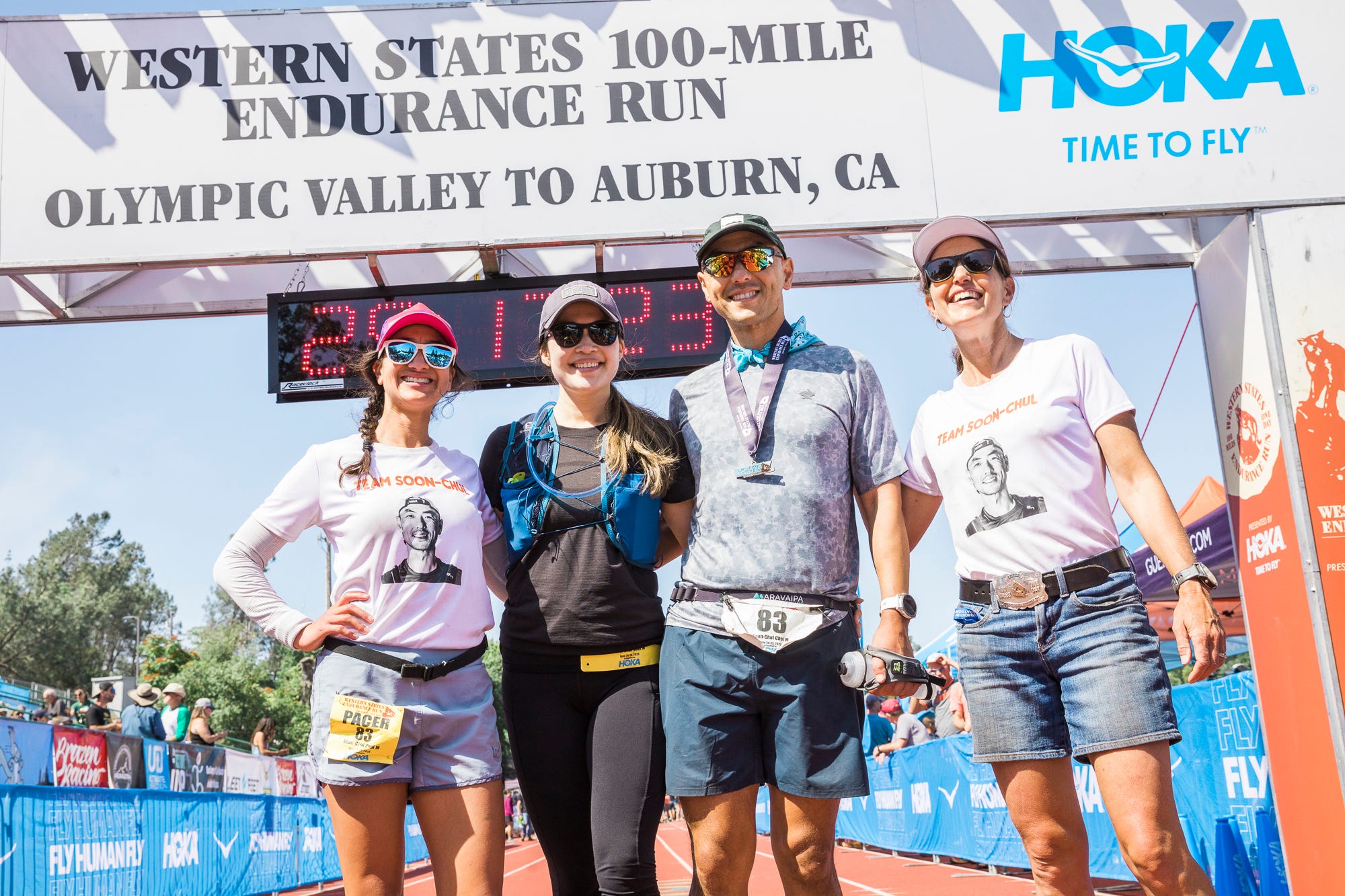
Congratulations to Soon-Chul (and team), and thanks for this insightful crew/pacer view of things. I have my own account to write (soon), and reading how other people saw things helps with that. I have to admit that I was mildly skeptical of the WSER hype, but I was absolutely wrong about that in nearly every way - I'm a full-on fan of this very worthy race now (and the celebration that surrounds it). My own performance was not what I'd hoped (thanks in part to a stomach bug that hit me and my crew), but I stuck it out and came away with so many memorable moments - a peak experience in every sense.
This was such a great write up. I sent it to my kids. Zoe helped with course marking and checking all 4 days and has announced that she’s officially “obsessed” with the race. It helps that Courtney is such a lovable role model. I guess this means we’ll have to keep doing the course marking for a lot of years to come. 😅